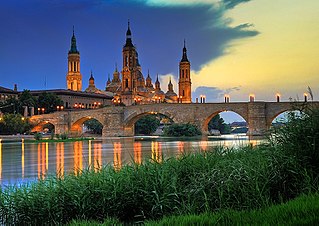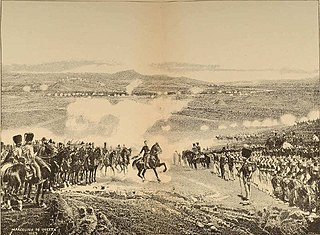
Tomás de Zumalacárregui e Imaz, 1st Duke of the Victory of the Amezcoas, 1st Count of Zumalacárregui, GE, OSH, known among his troops as "Uncle Tomás", was a Spanish Basque officer who lead the Carlist faction as Captain general of the Army during the First Carlist War. He was ocassionaly nicknamed the "Wolf of the Amezcoas", making reference to his famous military victory in said region of Navarre.

José Domingo de la Merced de la Mar y Cortázar was a Spanish and Peruvian military leader and politician who served as the second and eighth President of Peru.

Ramon Cabrera y Griñó, 1st Duke of Maestrazgo, 1st Count of Morella, 1st Marquess of Ter, GE, KOGF, OCIII was a Carlist general of Catalonia.

Spain in the 19th century was a country in turmoil. Occupied by Napoleon from 1808 to 1814, a massively destructive "war of independence" ensued, driven by an emergent Spanish nationalism. An era of reaction against the liberal ideas associated with revolutionary France followed the war, personified by the rule of Ferdinand VII and – to a lesser extent – his daughter Isabella II. Ferdinand's rule included the loss of the Spanish colonies in the New World, except for Cuba and Puerto Rico, in the 1810s and 1820s. A series of civil wars then broke out in Spain, pitting Spanish liberals and then republicans against conservatives, culminating in the Carlist Wars between the moderate Queen Isabella and her uncle, the reactionary Infante Carlos. Disaffection with Isabella's government from many quarters led to repeated military intervention in political affairs and to several revolutionary attempts against the government. Two of these revolutions were successful, the moderate Vicalvarada or "Vicálvaro Revolution" of 1854 and the more radical la Gloriosa in 1868. The latter marks the end of Isabella's monarchy. The brief rule of the liberal king Amadeo I of Spain ended in the establishment of the First Spanish Republic, only to be replaced in 1874 by the popular, moderate rule of Alfonso XII of Spain, which finally brought Spain into a period of stability and reform.

The Third Carlist War (1872–1876) was the last Carlist War in Spain. It is sometimes referred to as the "Second Carlist War", as the earlier "Second" War (1847–1849) was smaller in scale and relatively trivial in political consequence.
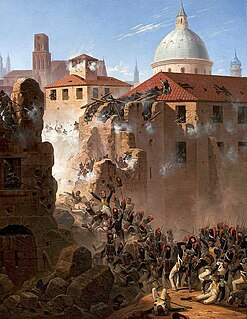
The First Siege of Zaragoza was a bloody struggle in the Peninsular War (1807–1814). A French army under General Lefebvre-Desnouettes and subsequently commanded by General Jean-Antoine Verdier besieged, repeatedly stormed, and was repulsed from the Spanish city of Zaragoza in the summer of 1808.
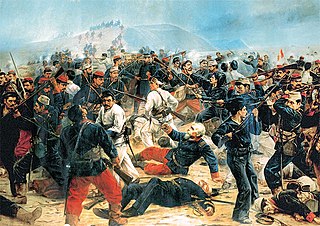
The Battle of Arica, also known as Assault and Capture of Cape Arica, was a battle in the War of the Pacific. It was fought on 7 June 1880, between the forces of Chile and Peru.

Daroca is a city and municipality in the province of Zaragoza, Aragon, Spain, situated to the south of the city of Zaragoza. It is the center of a judicial district.

Rafael Maroto Yserns was a Spanish general, known both for his involvement on the Spanish side in the wars of independence in South America and on the Carlist side in the First Carlist War.
The British Auxiliary Legion, also called the British Legion or Westminster Legion, existed from 1835 to 1837. It was a British military force sent to Spain to support the Liberals and Queen Isabella II of Spain against the Carlists in the First Carlist War.

The Battle of Maella was a battle of the First Carlist War, occurring on October 1, 1838, near the Aragonese town of Maella. The battle was a Carlist victory and resulted in the routing of most of the Liberal forces.

The Guías de Navarra were a Carlist battalion of the First Carlist War, created by Zumalacárregui in 1834.
The Battle of Venta de Echavarri, a battle of the First Carlist War, occurred on October 28, 1834. It was an immediate follow-up to the Battle of Alegría de Álava, which had occurred the day before. It was a Carlist victory.
The Battle of Épila was fought on July 21, 1348 near Zaragoza, in what is now Spain, between the supporters of the Union of Aragon and King Peter IV, led by Don Lope de Luna. This battle was the culmination of a long confrontation between a large segment of the nobility and the people of Aragon against the king, ending with the decisive defeat of the Union.
Anne Gilbert de Laval or Anne-Gilbert Laval or Anne Guilbert de La Val became a general officer during the French Revolutionary Wars and led a division in the Napoleonic Wars. Like many other officers, he saw rapid promotion during the French Revolution. He commanded a demi brigade beginning in 1794. He fought in numerous actions during the 1796 campaign in Germany, including the battles of Ettlingen and Neresheim.

The Battle of Saguntum saw the Imperial French Army of Aragon under Marshal Louis Gabriel Suchet fighting a Spanish army led by Captain General Joaquín Blake. The Spanish attempt to raise the siege of the Sagunto Castle failed when the French, Italians, and Poles drove their troops off the battlefield in rout. The action took place during the Peninsular War, part of the Napoleonic Wars. Sagunto lies a short distance from the east coast of Spain, about 30 kilometres (19 mi) north of Valencia.

Basilio Antonio García y Velasco, known as "Don Basilio de Logroño" in the newspapers of that time, was a Spanish soldier and Carlist military commander.
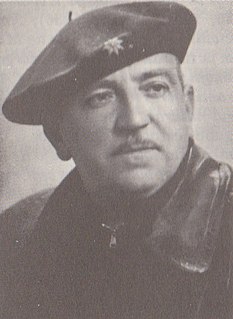
Jesús Comín y Sagüés was a Spanish Carlist politician and soldier. He has been twice elected deputy to the Republican Cortes. He is also recognized for his role during early days of the Civil War, when he decisively contributed to Nationalist seizure of Zaragoza and large part of Aragón.

The Battle of Andoain was a battle fought on 14 September 1837, during the First Carlist War in northern Spain. The action took place in Andoain, south of the main Liberal stronghold of San Sebastián. Liberal troops, led by the Spanish General Leopoldo O'Donnell, had captured Andoain on 9 September, driving the Carlist garrison to the western bank of the river Oria. Then followed a three-day period of breastwork building by both sides and sporadic fighting. After two days of trench warfare, the Carlist poured heavy artillery fire on the Liberals lines and launched an all-out offensive by midday supported by reinforcements brought in from Navarra by General José Ignacio de Uranga. The Liberals were flanked on their left wing, and their lines crumbled. Only two British Auxiliary Legion Regiments and a number of their Basque local guides, the Chapelgorris, were left to resist the Carlist advance, but were eventually outnumbered and overran. Most of the British who surrendered to the Carlists were executed, accused of the burning of several local farms in the previous days. The battle was the end of the British Auxiliary Legion as an effective fighting force, with two-thirds of their members killed, wounded or executed by the Carlists and local civilian residents. General O´Donnell and the remnants of his forces withdrew to Hernani.

